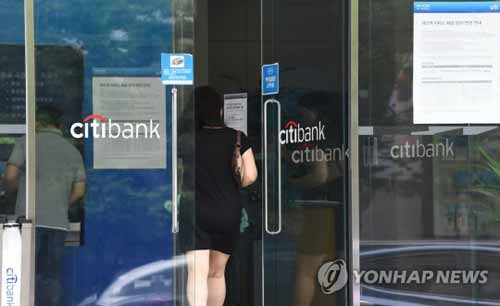Even US closing bank branches… 1765 branches to have been disappeared in a year
Lee Mi Jong | lmj0919@ | 2018-02-28 11:32:07

The expansion of digital finance, including mobile banking, is accelerating the closure of major US banks. The picture shows a sign posted on the Yeoksam-dong branch of the Korea Citibank in Gangnam-gu, Seoul last July to inform you of the branch closure. Photo by Yonhap news
According to an analysis of the Federal Deposit Insurance Corporation (FDIC) data on February 27 by the Hankook Tire for the first time in the history of the banking industry, the number of banking stores closed all over the United States during the previous 12 months was 1765.
The shrinking of banking stores, which started in the wake of the financial crisis, has been the longest period since the Great Depression. Many banks are trying to reduce their sales points in order to reduce costs in the wake of the financial crisis, worrying about profitability deterioration caused by rising regulatory costs.
In large cities and metropolitan areas with high store ratios, restructuring is being carried out in consideration of the reception size per store and the distance from the nearest store where existing store customers can go when the stores are closed.
Meanwhile, large banks such as Citigroup and Bank of America, which were hit hard by the financial crisis, have been reducing their stores from a year ago, and local banks have begun to reduce their stores.
In the suburbs, the number of stores of large credit companies is decreasing. In particular, Capital One Financial accounted for 32% of total branches for five years from mid-2012 to mid-2017, while SunTrust Bank reduced its number of stores by 22% and Regus Financial by 12% over the same period.
Banks are still receiving the right amount of mobile banking and cash dispenser (ATM) preference despite such moves.
Bank of America has shut down more than 1,500 stores in suburbs since 2009, but has achieved its highest annual net profit last year due to cost savings.
Domestic banks are also trying to shrink stores. In order to streamline management, restructuring work, including the merger and consolidation of stores, is taking off.
Last year, domestic banks shrank 200 stores. Shinhan, Korea, Korea, KEB Han, and Nonghyup Bank organized 189 stores last year and 4750 stores as of the end of last year.
As such, US and domestic banks are trying to shrink stores to streamline operations, but the US is also opening new stores.
US banks are also opening new stores to expand their markets, such as entering new markets in the region, though not as much as the rate of reducing stores. Bank of America is expanding its stores around major metropolitan areas, and JP Morgan will open more than 400 new stores around new regional markets.
Hana Financial Research Institute suggests that domestic banks need to consider a comprehensive store operation plan that considers both customer expansion and cost efficiency in addition to the recent efforts to transform existing stores. Kim Ji-hyun, a senior researcher at the Hana Financial Management Institute, said, "Domestic banks are gradually dropping the efficiency of their banking stores due to the introduction of Internet-based specialty banks." In the future, we will focus on store channel management strategies in terms of profitability, cost efficiency and it is necessary to establish a store operation plan considering the comprehensive consideration, "he advised.
By Lee Mi Jong lmj0919@
